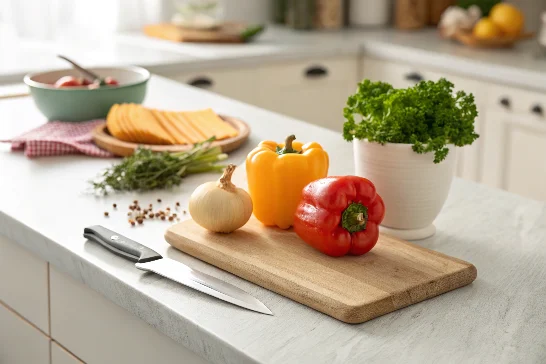Looking for a sajata recipe? This guide will explore a naturally simple approach to cooking. Moreover, you’ll discover flavor and ease as you learn about making a sajata recipe at home.
A sajata recipe often highlights simple cooking methods with natural ingredients. Consequently, these recipes aim to celebrate fresh flavors. Now, let’s explore these dishes and their easy preparation.
Naturally Simple Cooking: The Sajata Approach
The sajata style emphasizes making food that is both delicious and achievable. The focus is on using natural elements and simple steps. The goal is to bring joy into every home, reflecting a naturally approachable culinary style.

Highlighting Natural Flavors in a Sajata Recipe
A sajata recipe often highlights natural flavors, showcasing the inherent taste of each ingredient. Moreover, freshness plays a key role in these dishes. With minimal enhancements, the natural taste truly shines through. As a result, this approach allows you to fully appreciate the simplicity and authenticity of the food.
Minimalist Approach to Ingredients in a Sajata Recipe
A sajata recipe typically uses a small number of ingredients. This minimalist approach makes the recipes easy to follow. Additionally, this shows that simple dishes can be flavorful. Therefore, preparation is quick and easy. This makes the recipes compatible with busy lives.
Naturally Easy Techniques for a Sajata Recipe
The techniques used in a sajata recipe are straightforward and easy to follow, avoiding complicated steps. Designed for all skill levels, these methods make cooking more approachable. As a result, they help build confidence in the kitchen, allowing anyone to successfully prepare a sajata recipe with ease.
Exploring a Classic Sajata Recipe: A Vegetable Dish
While specific recipes vary, let’s explore a dish embodying the sajata style. This recipe showcases natural flavors with simple methods. It will reflect the easy and naturally satisfying nature of these dishes.
A Hypothetical Naturally Simple Roasted Vegetable Dish
This roasted vegetable dish captures the simplicity of a sajata recipe. It uses a few key ingredients and basic techniques. Specifically, the natural flavors of the vegetables shine. The preparation is easy for all skill levels and is a great starting point to understand a sajata recipe.

Ingredients for the Naturally Simple Roasted Vegetables
This sajata recipe uses a few basic ingredients:
- A mix of fresh vegetables (such as bell peppers, onions, zucchini, and carrots)
- Naturally dried herbs (such as oregano and thyme)
- Salt and pepper
- Olive oil
Steps for the Naturally Simple Roasted Vegetables
These steps are easy to follow for a sajata recipe:
- Preheat the oven to 400°F (200°C).
- Chop the vegetables into bite-sized pieces.
- Place the vegetables in a roasting pan.
- Drizzle the vegetables with olive oil.
- Sprinkle with salt, pepper, and dried herbs.
- Roast for 20-25 minutes, or until the vegetables are tender.
The Naturally Delicious Result
The result is a dish with naturally sweet and savory roasted vegetables. The herbs add a wonderful aroma. The simple seasoning lets the flavors shine. This shows how a few steps result in a great meal that is typical for a sajata recipe.
Naturally Using Fresh Ingredients in a Sajata Recipe
Fresh ingredients are a priority in the sajata approach. They bring out the best natural flavors. Freshness is a key part of this cooking style, ensuring that every sajata recipe is both delicious and healthy.
The Importance of Fresh Vegetables
Fresh vegetables are essential. Their vibrant flavors enhance any dish. They also provide great nutrients. A sajata recipe uses seasonal produce to naturally enhance flavor and also takes advantage of what’s fresh.
Prioritizing Fresh Proteins
Fresh proteins, like poultry and fish, are also important. Choosing fresh options improves the recipe. Furthermore, naturally sourced proteins are often chosen. This contributes to the overall freshness and quality of the final dish, which is typical of a sajata recipe.
Simple Ways to Use Fresh Herbs
Fresh herbs enhance any sajata recipe. They are added at the end for the best flavor. For example, sprinkling fresh basil can add a lot of flavor. These fresh herbs help elevate a simple dish.
Naturally Adapting the Sajata Style
Her philosophy is easy to incorporate into your own cooking, making it simple to adapt her approach to your meals. By embracing her methods, you can create delicious dishes with ease. Ultimately, the emphasis remains on simplicity, convenience, and the celebration of natural flavors.

Focus on a Few Key Ingredients
When creating your own recipes, focus on a few key ingredients. This will make the recipes easier to follow and it will also allow the natural flavors to shine through. Specifically, fewer ingredients often lead to better-tasting dishes, which is a hallmark of a sajata recipe.
Keep Techniques Simple
Use techniques that are simple and easy to follow, avoiding any complex or hard-to-master steps. This allows the process to be enjoyable and it also will help build your cooking confidence, as you can easily achieve a delicious result even when following a sajata recipe.
Allow Natural Flavors to Shine
Allow the natural flavors of your ingredients to shine, by avoiding over-seasoning or over-cooking your food. The idea is to enhance, not mask, the natural flavors. This also makes cooking more healthy and also more aligned with a sajata recipe.
A Naturally Balanced Sajata Meal
A meal inspired by the sajata style should be both flavorful and balanced, featuring a harmonious mix of proteins, vegetables, and simple carbohydrates. This combination not only ensures a nutritious meal but also provides a satisfying and enjoyable dining experience.
The Importance of Protein
Protein is a very important part of these meals. They often include lean proteins like chicken, fish, or lentils. These proteins provide essential nutrients. They also help to keep you full for longer, and therefore it’s important to include it in a meal inspired by a sajata recipe.
Including Vegetables
Vegetables are also very important in her meals. They include fresh vegetables, often roasted, steamed, or raw. This ensures a source of vitamins and fiber. Vegetables help to make meals healthier and more aligned with a sajata recipe.
Choosing Simple Carbohydrates
Simple carbohydrates are used. These are typically whole grain options. Examples include brown rice or whole grain bread. This helps to provide sustained energy. These options are compatible with the overall approach.
Naturally Enhancing Your Cooking Skills
The sajata approach can help enhance your cooking skills by focusing on building confidence in the kitchen. It encourages experimentation and the exploration of new flavors, making the process both enjoyable and rewarding. Embracing this philosophy is an excellent way to refine your culinary abilities while fostering creativity and a love for cooking.
Building Confidence in the Kitchen
Her emphasis on simplicity makes cooking more approachable. This helps to build confidence. Her recipes are easy to follow for beginners. This encourages cooking more often, as they are very easy to master, particularly with a sajata recipe.
Exploring New Flavors and Textures
The sajata style encourages you to explore new flavors and textures. This can help you discover new preferences. Furthermore, it also can make cooking more exciting. This also promotes a better appreciation of the food.
Understanding Ingredients Better
The focus on natural ingredients helps you to understand food better. You will notice how different flavors combine. This helps develop greater culinary awareness and also promotes freshness. Therefore, you learn so much from a sajata recipe.
Naturally Enjoying the Process
Finally, her philosophy is about enjoying the cooking process. It is about savoring the experience of making a meal and using fresh and natural ingredients to create a meal that you can be proud of.
Savoring the Act of Cooking
The sajata style emphasizes savoring the process, and it invites you to truly be in the moment when creating a meal. Enjoy the act of cooking. Cooking is a great way to express creativity and is also a great way to approach food with a sense of joy.
Sharing Food with Others
Sharing food with others is also a core aspect of this approach. Enjoying a meal together creates opportunities for connection. It fosters relationships and strengthens bonds among people. Food often brings people together. Thus, it is a gift to share a meal inspired by the sajata approach.
The Naturally Rewarding Results
The best part is enjoying the results of your work. Seeing how simple ingredients transform into a satisfying meal is rewarding, and that is the goal of a sajata recipe. Therefore, it is always great to see how simple steps can make amazing food.
Conclusion
The sajata style of cooking centers on simplicity, natural flavors, and fresh ingredients, making it both accessible and enjoyable for everyone. By focusing on a few key ingredients and straightforward techniques, you can craft impressive meals at home that celebrate the essence of natural flavors. This approach emphasizes the beauty of cooking with fresh, wholesome items, encouraging you to explore new tastes while savoring the process.
If you’re looking to expand your culinary repertoire further, check out these best smoker recipe ideas. They pair perfectly with the sajata philosophy, offering creative ways to bring out bold, natural flavors.
Ultimately, a sajata recipe serves as your guide to creating dishes that are both delightful and satisfying.


2 thoughts on “Sajata Recipe: Naturally Delicious & Simple”